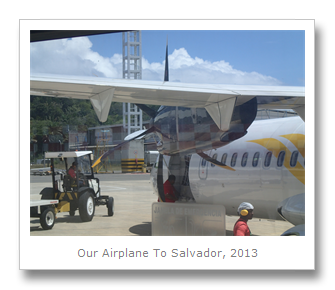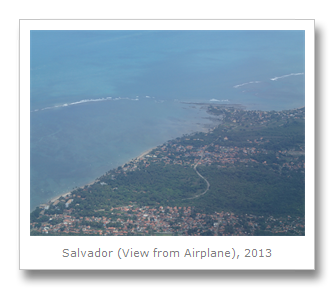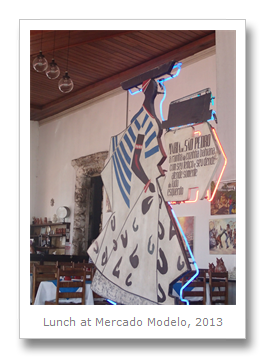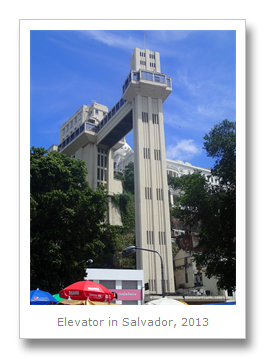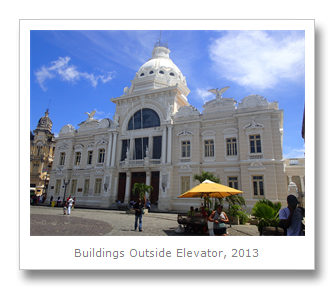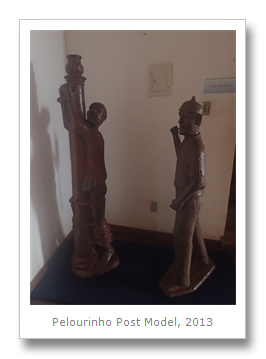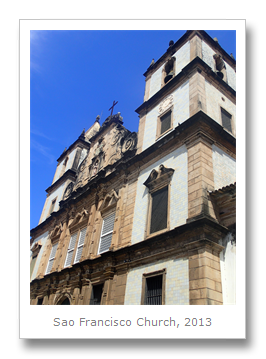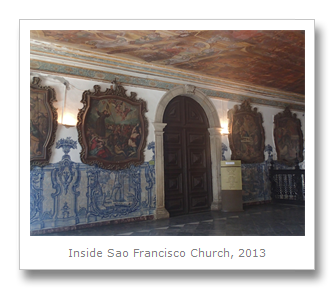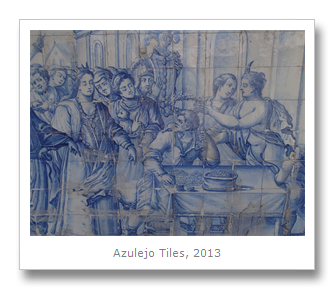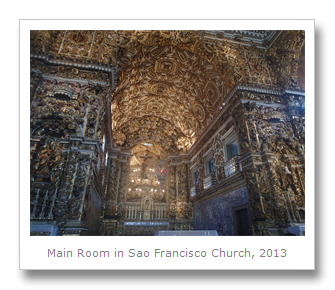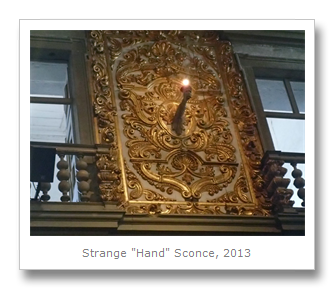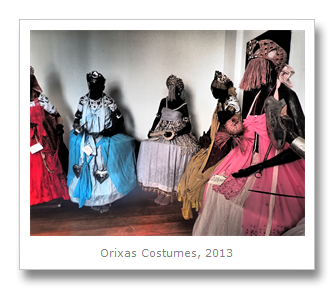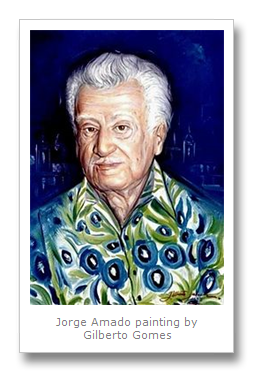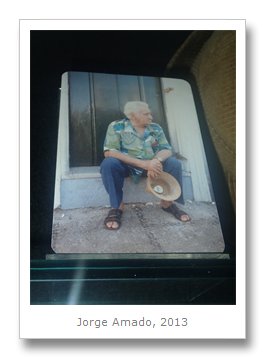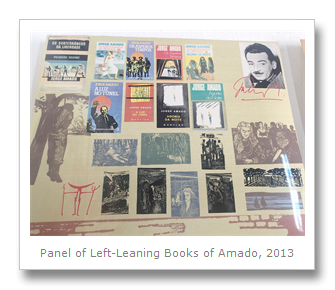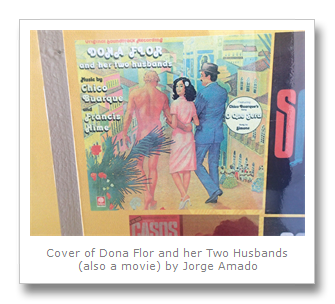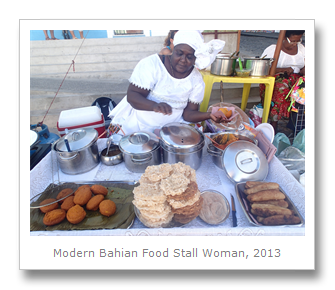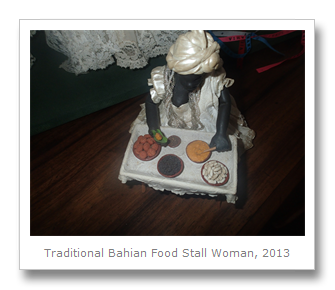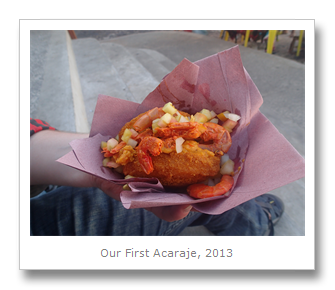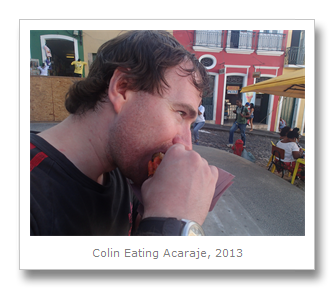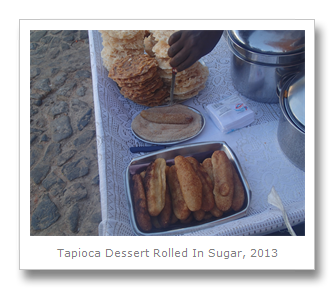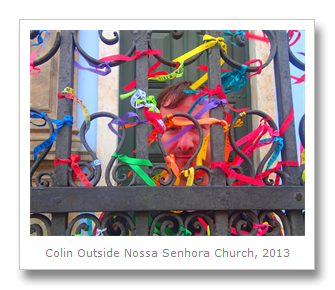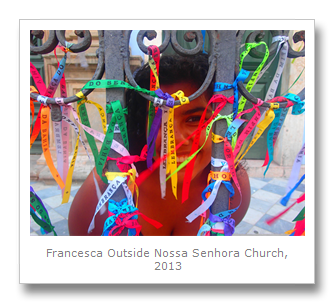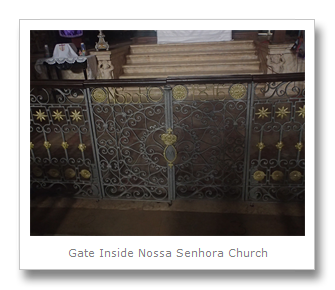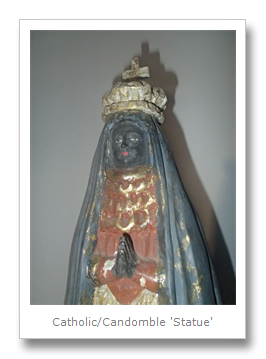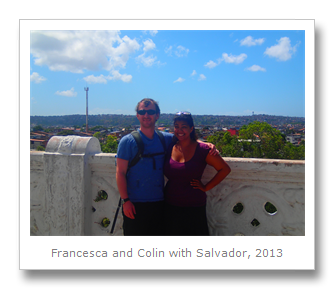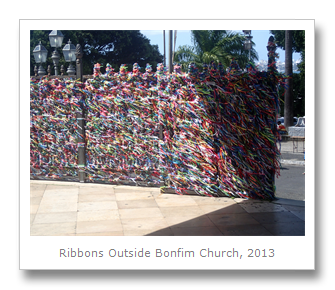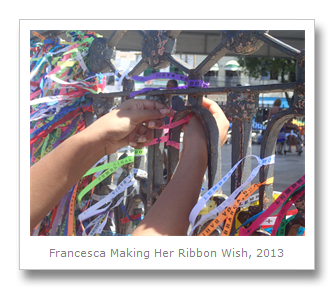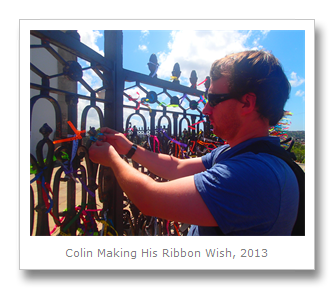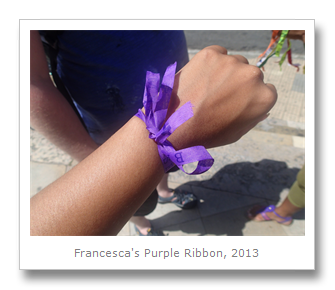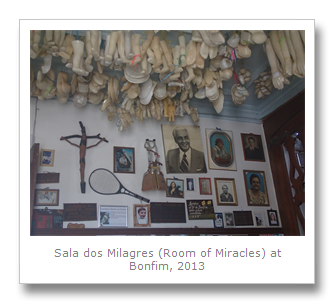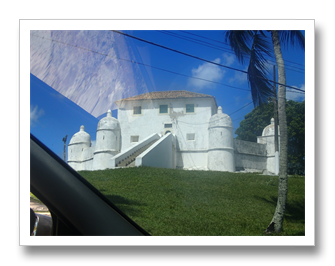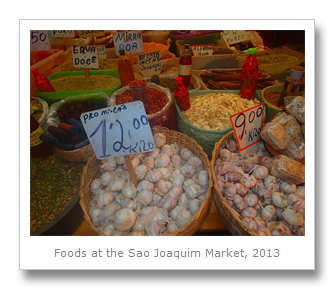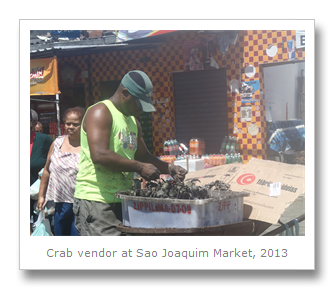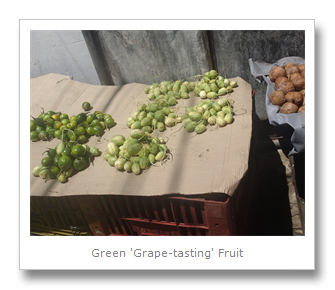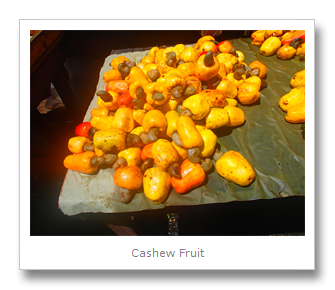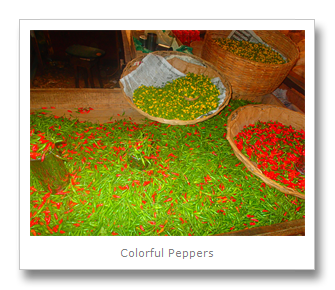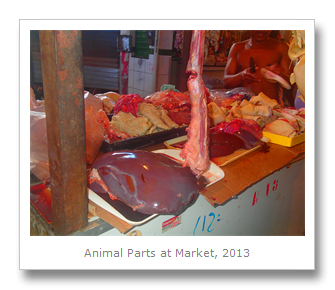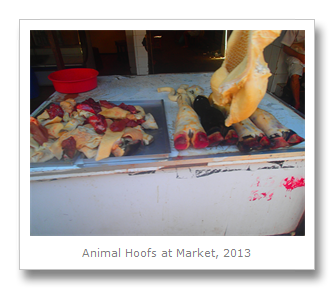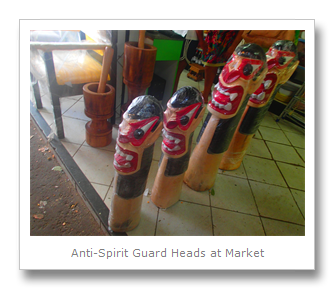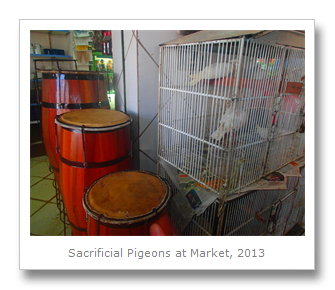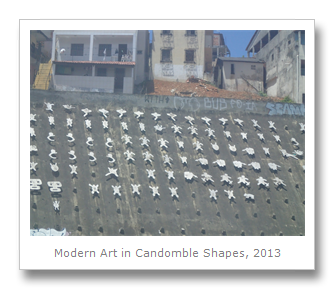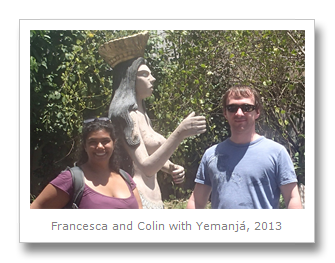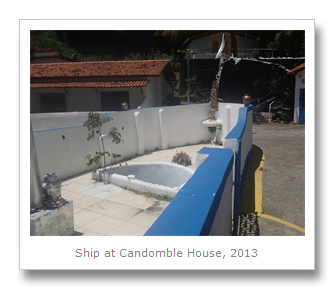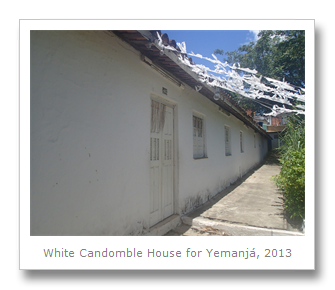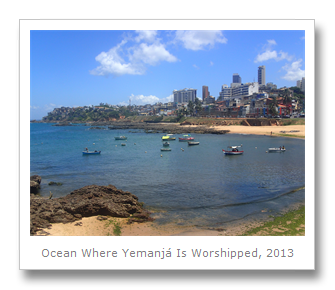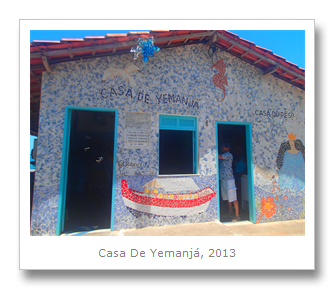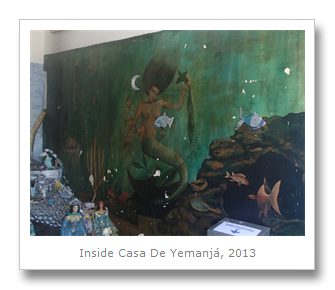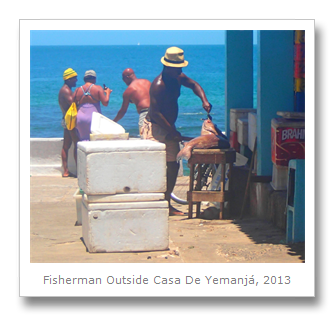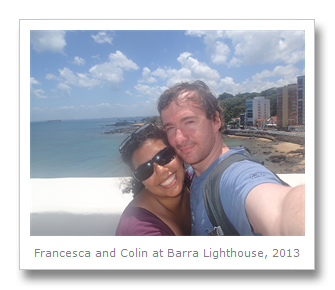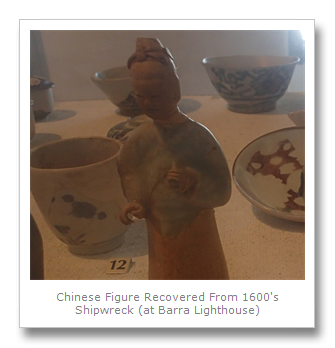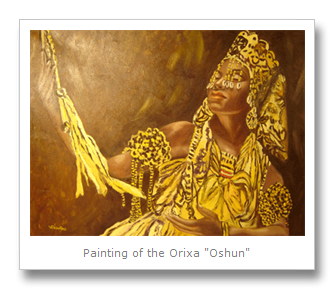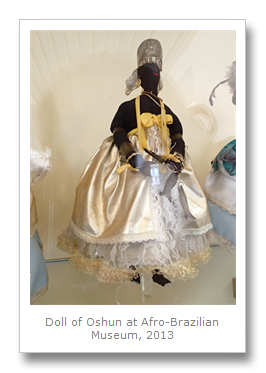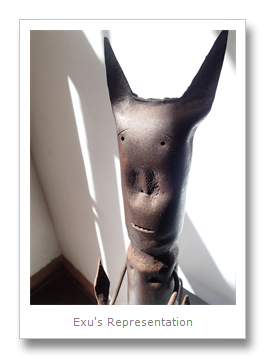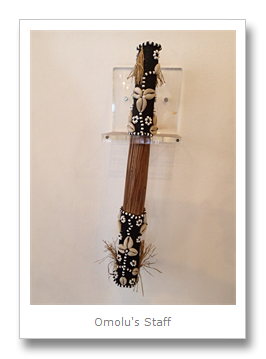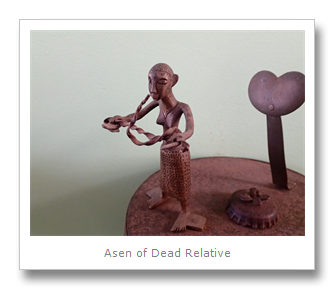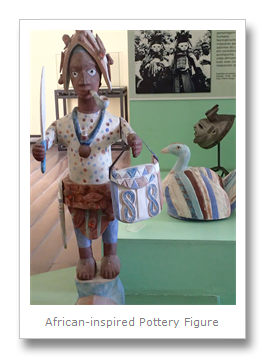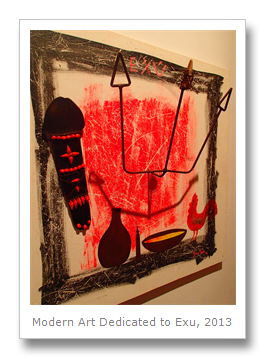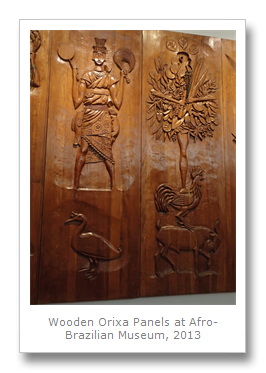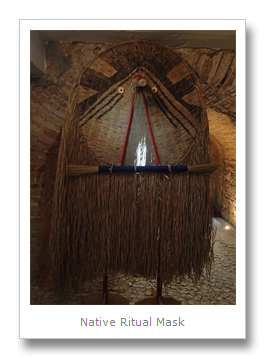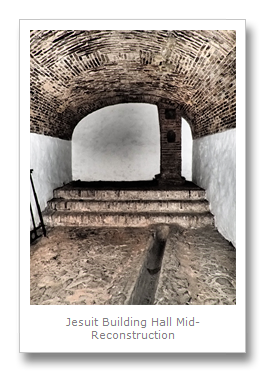Salvador is one of Brazil’s coolest cultural centers by far. The morning of the 26th, Colin and I touched down in the former capital city and scrambled to find a hotel once at the airport. While booking one online, we became immediately aware just how different this city was from the rest of Brazil: the shops around us were filled with bright, colorful objects, many with ribbons and black figures wearing colorful dress. We were in the center of the Afro-Brazilian region and the religion Candomble, which we were excited to learn more about during our stay. Once our hotel was booked we found a free bus out of the airport. It didn’t have air-con, so we sweated the whole way to the residential neighborhood of Barra, but the breeze from the coastline the road ran along (which was stunning beach after beach!) gave us some relief.
Salvador, meaning “Savior of the Bay of All Saints,” was formerly the capital of Brazil, before the capital moved to Rio, then Brasilia. It is clear that Salvador still retained much of the mixed culture that makes up Brazil, and the former-capital continues its colorful, laid-back way of life… the vibe we got upon arriving was instantly different than any other Brazilian city so far.
While we arrived on the 26th, we spent our first couple of days resting up in the Hostel Porto Salvador and finalizing our Brazil travel plan, with only short jaunts to get pizza or Subway our outings. We quickly realized the place we chose wasn’t the best. While the room was large and had great AC, there was loud construction noise directly outside our room. WIFI reception was also extremely spotty, even downstairs directly near the router. I found a new place online called Barra Guest House that we booked into instead, which we switched to on the 28th of Feb. One of the girls who worked there, Olivia, helped us book onto some tours, and gave us some tips on what to do in the historical part of Salvador. It wasn’t until March 1st that we made it to the historical district, but luckily it was worth the wait…
Colin and I took the bus down to the UNESCO-site historical center, and took Olivia’s suggestion to try the huge elevator before the center. Just 15 cents, we took it down to the tourist market below, the Mercado Modelo, which had tons of shops and really interesting things to browse. I saw some colorful dresses with names of Bahian attractions on them and some cool but strange statues I wished we could buy! (One downside of backpacking with minimal stuff – not much room for large souvenirs!) We weren’t sure what to buy yet, so we decided to think about it over lunch at the upstairs eatery where we shared chicken and chips (plus some manioc – it is Brazil!) served by traditionally dressed Salvador women.
Once back up the elevator, we made our way to the historical center. The historical center is actually one of the oldest cities in the Americas, founded in 1549 by the Portuguese. It also was the first locations in the Americas to have a robust slave industry. The historical center itself is known to locals as the Pelourinho, named for the whipping post (which was located in the square) where African slaves received punishment for various infractions, as well as for disciplinary purposes. The square was a place of meeting and convergence with houses of aristocrats and those seeking to gain social status.
The first place we went into was the Sao Francisco Church – and once past the entrance hall, constructed in the mid 1700s, we were amazed. The convent was decorated with beautiful, crisp-looking blue-and-white porcelain tiles (known as “azulejo”) imported from Portugal made up dozens of murals referencing Biblical and social themes based on 17th century-Flemish engravings complete with sayings by the Roman poet Horace. The scenes, crafted by Bartolomeu Antunes de Jesus, also made commentary on the hopes and temptations of the Catholic flock during Portuguese rule in the 1700s-1800s.
After walking around the azulejo panels, we arrived at the main hall of the church, which was so incredibly gilded it almost hurt your eyes to look at because there was simply so much of the Baroque style covering the huge room. Here were also more tiles, this time depicting scenes from the life of St. Francis of Assisi, but they were almost lost among the extravagant gilt work. My favorite touch was the gold sconce “hands” holding up the lighting torches. Creepy, but elegant.
After the church, we made our way back into the main square. We tried to visit the cultural center in the square, but found a strange message on the door saying it was closed until the “strike of vigilantes” – we think it has something to do with the place being vandalized. Luckily, there was a little museum right on the square that was filled with information about the Orixas and examples of the costumes worn by Candomble believers who take on their representation during festivals. Colin and I learned that the Candomble religion is closely related with the notion of family. In fact, Orixas actually represent deified ancestors of African people such as the Orixas “Xango,” who researchers gather was an ancient king of the Yoruba people (21% of Nigeria) in Africa. It is believed that deified ancestors gained a control over nature’s forces or human activities, thus each Orixa is linked with a specific natural force or activity (such as the waters or hunting,) colors, and properties.
After a quick ice-cream and water break, Colin and I decided to continue with museums and find out who exactly Jorge Amado was by heading inside the museum about him.
Turns out he was an extremely influential (and ambitious – over 25 books, each one sounding intriguing!) Brazilian writer. Born on a farm near cocoa plantations, Amado wrote stories that captured and spoke about what Bahian life was like in the region. The museum was fantastic, with pictures and panels describing each of Amado’s books along with the progression of his life and literary style.
One of the things that amazed us the most, besides the sheer volume of books Amado managed to write, was just how early he started his craft. His first successful book, The Country of Carnival, was written when he was just 18, in 1931. Not just a writer who described his local living circumstances, Amado was actually very politically active as well – leaning strongly to the left, even becoming a member of the Brazil Communist Party before the party was declared illegal.
Obviously, all of this made him a target – he was arresting multiple times, his books burned – the dictatorship under Vargas would not stand for his activity or popularity. After WWII ended, Amado returned from Europe to Brazil, leaving the political world to focus on his writing, which progressed into depicting the sexuality of Bahian woman. By this point Amado was a national figure, even accepted into Candomble religion, by receiving the title of Obá de Xangô. (This makes him a protector of Xango, who is one of Candomble’s Orixas.)
After the museum we were still pretty hungry, so we decided to get some local food from the woman we found outside. Preparing traditional Bahian food, she is known as a “baianas,” and was dressed in clothes of the former slave women. These outfits combine European, African, and Brazilian style of dress. Her outfit and food cart actually reminded me of one of the figures I saw before in the craft museum. She for yourself. ![]()
We weren’t quite sure what she was serving when we walked up to the cart, but we quickly found out it was acaraje. This Bahian dish is basically a ball of black-eyed peas which is deep-fried in palm oil. It combines Nigerian flavors (origin of many Brazilian slaves) and is very popular as ritual food, eaten in Candomble ceremonies. Our acaraje was cut in half and stuffed with a shrimp-cashew paste, green and red tomatoes, then topped with fried shrimps. It was crunchy on the outside and fluffy on the inside, but the ground peas made it pretty grainy. Great to try something local and with so much history attached to it, but I don’t think it will become our favorite dish anytime soon… (especially as most Brazilian cooking doesn’t shell their shrimps. Cooked shell? Too hard to eat…) Later we also tried the traditional tapioca dessert, which is rolled in brown sugar and ends up tasting something like a churro, or a Bahian doughnut. Crispy yet soft and sweet… I will definitely be trying that one again!
After our snack, we went over to the Nossa Senhora do Rosario dos Pretos also known as “Our Lady of the Rosary of Black People” Church. This church, built in 1816, was not as ornate as the one we saw earlier that day, but there was a lot more attached to it as far as history of blacks in the area, in fact, the church is actually one of the “unofficial headquarters” of Candomble. Many of the Saints inside actually represent African Orixas in Candomble, for example, take a look at the statue below.
Shortly after we went to the Terreiro de Jesus (one of the nearby squares) into a Basilica Cathedral built by the Jesuits, which is now a church for Saint Francis. The church had an incredible ceiling, enlarged here so you can see the detail. There was mass in progress while we were there, so we didn’t spend too long there. Instead, we headed to cool down back in the Jorge Amado museum with some drinks while we decided if we should stick around for the evening show we planned or come back the next evening. We decided to put it off as it had already been a full day… and have some Subway take-away instead.The morning of March 2nd, we were scheduled to take a Panoramic tour of the city. This started with our guide (a local woman named Nilzete whom you can reach by emailing afro.tours@hotmail.com, who practiced Candomble!) picking us up and driving us back towards the market and elevators we visited the day before, bringing us to the Bonfim Church while telling us all about the city.
The outside of the Bonfim Church was covered in different colored ribbons fluttering in the wind, tied to the gate of the Church. We bought a pack of assorted color ribbons (you get one ribbon in each rainbow color per pack) and tied two to the Church gate – 1 hot pink and 1 bright blue. These multicolored ribbons represent a syncretism between African Candomble faith and the Catholic faith, as the colors represent the various Orixas as well as their corresponding Catholic saints. Tied traditionally by using 3 knots around the gate, one lets each ribbon represent a wish. Colin and I tied two of the remaining ribbons around each others’ wrists (you are supposed to gift the ribbons) – although we didn’t quite wait until they fell off on their own, as is traditionally required.
Inside the Bonfim Church we found the unique and slightly eerie Sala dos Milagres (Room of Miracles.) This room has “ex-votos” hanging from the ceiling - plastic body parts (arms, legs, organs, etc.) which serve as representatives body parts that have been cured or need curing by faith for the believer. The walls of the room had a huge collection of objects: photos of wounded body parts and healing that has occurred; prized possessions given to the church in exchange for healing; artifacts from military or political successes achieved; and other letters of testimony telling believers’ stories of healing or success through faith.After the church, we continued our tour by driving around the Solar do Unhao (an old sugar mill from the 1800’s) and the Forte De Nossa Senhora De Montserrat. This fort was built in 1586 to provide protection for the Port of Salvador and still stands despite the battles its seen against the Dutch .
Once we arrived at Sao Jaoquim Market, Colin and I felt as if we were really transported back in time to experience what markets during the Portuguese-rule might have been like. This market is known as a local rather a tourist market, so we didn’t see any other tourists while we were there. There were tons of exotic fruits (we tried the smooth green one in the photo – tasted like a giant, really sweet grape!) and spices used in Bahian cooking, as well as animal parts all of over the place. Organs, hoofs, they use everything for something here!
Everywhere we looked there seemed to be another surprise waiting for us to see. There were also a bunch of Candomble ritual artifacts around such as these monster-looking heads that stand guard outside Candomble houses for protection and images of the various Orixas. There were even some white pigeons in cages we passed, which Nilzete told us were for sacrificial purposes…
Back in the car, we drove past a few more interesting sites. The World Cup stadium, which we were told is being worked on 24/7 (and it’s true, we drove by later at night and they were still working,) and the Dique do Tororo, a lake with large Orixa statues dancing in a circle on it, and some modern art in shapes significant to the religion of Candomble.
Our next stop was a Candomble house used for the celebrations related to the Orixa of the ocean and motherhood, named Yemanjá. She is considered a protector of fishermen and sailors and is often depicted as a mermaid and syncretized with the Virgin Mary in Catholicism. The house and the elements outside were related to the sea, from the faux ship outside with blues, whites, and silvers. We were really taken by the purity of the white house we climbed up to above – which is where the actual yearly ceremony took place. This house was actually frequented by the writer we learned about the previous day, Jorge Amado.
We continued learning about Yemanja by heading to the ocean where she is worshipped during festivals. Candomble worshippers come to this area pictured below and lay out flowers on the water as offerings for the mother goddess, especially in February when there is a big celebration for her. There was a little house of worship called the Casa De Yemanja near the water, filled with images of her as a mermaid. Significantly, there were a bunch of fisherman (whom she is said to protect) nearby, cleaning and gutting their catch of the day.
Our tour was nearly over, and we asked to be dropped off near the Barra Lighthouse in order to explore it on our way. The lighthouse is actually an ancient Portuguese fort, built in 1534 to guard against the Dutch. We purchased tickets and made our way up the stairs to see maps all over the walls showing various ocean routes and blueprints of how some of the lighthouse objects work.
There were panels on the walls that told the story of the Sacramento, a ship which wrecked due to a violent storm in the 1660’s, and was only recently brought up from the ocean floor. Storage jars for olives and oils, blue-and-white pottery, and even old Chinese statues of maids were found among the wreckage, having survived the waters. Colin and I walked up to the top of the lighthouse for an amazing view of the beach and waters around us. Finished with our birds-eye view, we had lunch back towards the hostel – treating ourselves to a tasty ice-cream and chocolate cake dessert. Yum!
Later that evening, we ended up at the mall trying to arrange some plane tickets. Unfortunately, due to the ‘budget carriers don’t take foreign cards rule,’ we couldn’t purchase them right away. We said we would come back the next day and grabbed a taxi of to an evening theater show back in the historical center at Teatro Miguel Santana. Best $20 USD we spent the whole time in Brazil so far! The performance was absolutely captivating. It was just an hour in a small, intimate setting, and we were left wanting so much more because it was just SO good!
The dancers were very fit for a start – but the rhythm was strong, the beat of the music was great and the story each short performance told really gave you the spirit of the Afro-Brazilian culture. We saw them perform a dance version of the African martial art called capoeira, a fire dance dedicated to Xango the god of fire in which a danced with, played with, swallowed, and stepped all over fire, a slow and heavenly dance to Yemanja, a dramatic and violent stick/war-like dance performed by the slaves in the Brazilian colonial period celebrating the end of the sugar-cane harvest (also used as a defense against slave-owners,) and other dances highlighting various Orixas in the “pantheon” and their traits.
I found one of their videos on YouTube, but check out the ones on their website as well.
Here is a link to more videos of their performance: http://www.balefolcloricodabahia.com.br/eng/guestbook.html
The next morning Colin went out to pick up our plane tickets to the island of Fernando de Naronha, and purchase our bus tickets onward to Maceio. On the way back, he stopped off to get some take-away Subway for us (yet again!) and when he got back to the room, he told me a scary story:
“I was in Subway, already having ordered the subs and waiting for them to be wrapped so I could place the all important cookie and chips orders, when all of a sudden there was a load of commotion outside. Everyone sitting outside of the shop came running in, including the manager, who promptly locked the door, and locked us inside. I moved to the glass door to get a look outside, and saw people scattering in all directions, children in arms. I looked to the sea, all of the tsunami images I had seen on TV flashing through my mind! Then I saw cops running towards the beach with their pistols drawn. I asked the girl behind the counter what was going on, in English, and she made a gun sign with her two fingers and said there was shooting. It was at this point I realized that everyone else was well away from the window, and I had better move away too! They carried on serving in Subway, so I got my food together and paid. They unlocked the door about 2 minutes later, and so I left. Outside there were large groups of people gathered – I could not see anyone who had been shot, but there were still some hiding behind vehicles. Lots of people were still on the beach but were now all looking down into the water. I turned left onto the road leading back towards our hostel – and 30 seconds later I heard a gunshot, followed by many people shouting and screaming and then multiple pops of multiple gunshots. I hurried on back to the hostel, stopping only for some water in a little café. It was pretty scary at first, but I’m just glad it was not a tsunami.”
A little later, Colin asked Olivia about the shooting, but she said she had not heard anything about it. Her subsequent Google search however revealed a local news story, in which it said two people were shot at by a man on the beach, and both were wounded. It said that the police then disarmed and arrested the suspect and put him in custody where he now protests his innocence. Apparently shootings are not that common in the tourist areas of Salvador, but crime is very common, including against tourists. Olivia said in her 5 years of being in Salvador, she had not heard of a single similar incident. In future I will make sure I keep Colin closure as he obviously should not be out on his own! If we had become complacent after travelling through some of the nicer areas of Brazil, this event certainly re-awoke us to the dangers of travelling here.
We had planned on going to the beach that afternoon, but after Colin’s story, we decided to not risk it and stayed in until it was time for our evening tour. For me, this was to be the highlight of our time in Salvador, as it touched on one of my passions – religious history. Nilzete came and got us from the hostel to bring us (along with a French couple) to the celebration of her religion. We had booked to go with her to a special Candomble festival for the Orixa known as “Oshun.” Oshun represents the eternal feminine, and her color is yellow. Because we knew this, we decided to wear yellow to the celebration. However, being backpacking travelers, we have limited clothes with us on the road and accidentally ended up wearing black, the color of the Orixa Exu, to the celebration. Luckily, we were able to get in without anyone complaining, but note to anyone who goes to a Candomble celebration – don’t risk it, wear white!
A bit more about Oshun I found online:
“She is a sweet water ORISHA, from springs and streams, owner of the OSHUN River and of all waters born in the earth. An esoteric tradition says that OSHUN is Mother Earth herself, a live self-regulating being, the rivers being her veins. OSHUN is essentially the women's ORISHA, presiding over menstruation, pregnancy and childbirth… Her day is Saturday, day of the waters, her color is golden yellow and the egg is consecrated to her for representing pregnancy. She loves honey, sweet like her. When OSHUN dances, she holds in her hand a sword and a mirror, revealing her condition of seduction warrior. She bathes herself in the river, combs her hair, wears her jewels and bracelets, all this in a slow and provoking movement. ORISHA of gold, of peace, of richness, she is essentially the Mother - generous, prodigal, and accommodating and, because of this, like OSHUN EWUJI is saluted in the PADE, the beginning of every ritual in the Candomblé.” (Levy, 1990)
When we got to the ceremony we weren’t allowed to take any photos, so I’ll have to try and describe it all to you using a few photos I took the next morning at the Afro-Brazilian Museum, which had a great display all about the Orixas. We got to the house which was huge, one main room, with large statues of the Orixas outside. Inside the house downstairs was segregated by gender, with large chairs for the high priests to sit it at “center stage.” The upstairs galleries (where we ended up sitting) were mixed gender and had a good view of everything going on down below. From the upstairs, we could clearly see the roof of the all-white room, which was covered completely in white strips of paper fluttering with the rare breeze.
We were told that earlier in the day a goat had been sacrificed in Oshun’s name, as that is her animal representation – this part of the ceremony was private. The public celebration we attended began with woman and a few men slowly dancing around in a circle with their hands doing small, choreographed movements. Each of the dancers (the dancers I was told had to be devout believers for at least 7 years) was dressed elaborately in the style of dress displayed on the doll below, and had different colors representing their personal Orixa who is “their spirit” to worship (because the Orixas’ personality matches that of their own.) Nilzete explained to us that the start of the ceremony was going to consist of dances to the different Orixas, with specific and different music and hand gestures for each Orixa. Below is an example of the style of dress worn by the believers, minus the headpiece and the accessories in their hands, those seemed to be reserved for the dancers representing the Orixas themselves.
There were two priests (they had to be devout for at least 21 years) present who were leading the ceremony, the main priest who was dressed in loose-fitting red clothes and lots of gold jewelry, that ran the Candomble house we were currently in (and I swear, his facial features looked exactly like Flava Flav… strange!) and a visiting priest from another house. They walked around with rattles/musical shakers and bells which seemed to have the dual use of keeping people in the moment and calling the Orixas to come to the ceremony in their honor. Joining that noise was a live band of drums and traditional African rattles and other instruments, which played a steady beat throughout the night, changing for the different dancing patterns. Walking around the dancers were others dressed in Orixa clothes as well, kissing and accepting kisses from those who had practiced for just 7 years. I found out that these believers were stationed in between the priests and the lower believers, and had to be practitioners for at least 14 years to earn this status. The dancers prostrated in front of the priests and hugged them frequently.
At some point during the dancing, some of the women went into a back room and came back with baskets of acaraja (the black-eye pea balls we ate earlier in the week) to hand out to everyone in the Candomble house. Colin and I got one and tried it – pretty much the same as what we experienced in the historical district. This food, the acaraja, was apparently the food of our Orixa being celebrated for the night – Oshun. Eventually, after the dancers representing other Orixas had their turn, we did get to see a dancer come out in a costume representing Oshun. She was wearing yellow and gold clothing, and her face was guarded with a beaded veil in front of it. As we saw in the show the other night, she danced carrying a mirror and looking at her face in it, as she representing the Orixa of feminine beauty and vanity.
As mentioned earlier and clarified during the evening by Nilzete, the various Orixas represent different aspects of nature and human life. If you are a believer of Candomble, you must go through an “Ife” with one of the priests, which is a 2 hour profiling session where you are asked questions to determine which Orixa resides within you as your spirit. The questions asked are sometimes psychological in nature, as personality plays a big role in determining your Orixa, and each Orixa has their own unique personality type. Here I quote below the personality type associated with Oshun and her followers:
“The psychological type of OSHUN's children is being physically very beautiful. They have well built bodies, usually fair and blond. They always represent the attractive type, and are always pursued by the opposite sex ( not like IANSAN, who pursues). They appreciate luxury and sex, they are vain, elegant, sensuous and like changes, maybe being unfaithful. But they are calm, tranquil, emotional, cry easily. They are smart, managing to get everything they want with imagination and plot. Though complacent and prodigal, they can be self-seeking, lazy and hesitant. They are very suspicious, and have a great intuition which is often put to work for artfulness.” (Levy, 1990)
You can visit this website to try and figure out which Orixa matches your personality type (read through the psychological type of each Orixa):
Candomble and Psychological Types
Throughout the evening, every so often it would look like someone was going into a “trance-like state.” Certain dancers were able to invoke and “incorporate” the Orixa’s essence, falling into a trance. The person then, while in trance, performs a dance symbolic of the Orixa’s attributes. We saw this happen with quite a few of the believers, many who started dancing wildly with great cheering from the crowd. It was really strange to see the believers going into the trance-state, we weren’t quite sure what to make of it – some of them looked extremely caught up in the moment and the spirit of their practice and it was quite mind-blowing to watch. We left around 11pm, but the party would continue on until early in the morning we were told.
Here is a video of a ceremony for Xango I found on YouTube, similar to what we went to, but for a different Orixa:
Before leaving Salvador, we really wanted to see the Afro-Brazilian museum. The next morning we check out of Barra Guest House and went to the historical district and tourist market for one last look. I bought a colorful shirt (which you will see me wearing in upcoming posts!) and after a pasta lunch near the museum, we bought our tickets and went inside.
The museum started with an overview of Orixas, with their dolls, symbols, and representations, followed by a more general history of Africans’ lives after being brought to the Americas. This general history told us about artifacts such as the metal art “asens,” which are made in order to honor the spirits of ancestors. Asens are made with words and objects that give reference to the deceased and serve as a ‘in between’ with the living and spirit world. The rest of the museum had some great pottery and metal pieces, even some modern art, but the real treat came at the very end when we entered a room which held more than 20 large, ornate wooden panels with carved images of the Orixas!
Connected to the Afro-Brazilian Museum was a small Anthropological museum that was mostly under construction. There were some interesting pieces, such as the masks and burial urns used by the native people living in Brazil before the Portuguese came. The most interesting thing however was actually the building itself, which was being reconstructed back to the state it looked during the time it was occupied by the Jesuits and served as the first Jesuit College in Brazil, as well as a hospital.Because this museum was mostly under-construction, we went through it pretty quickly, and decided to go to the mall for some AC and food before getting our bags from the hostel for our long bus journey. Full from our pizza dinner and pleased with our Caipirinha send-off Olivia fixed up for us back at the hostel, Colin and I arrived at the bus station and bought a couple snacks before tucking ourselves in for the overnight bus ride to Maceio.
Talk to you all again soon,
Francesca
